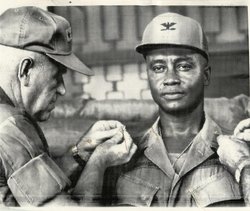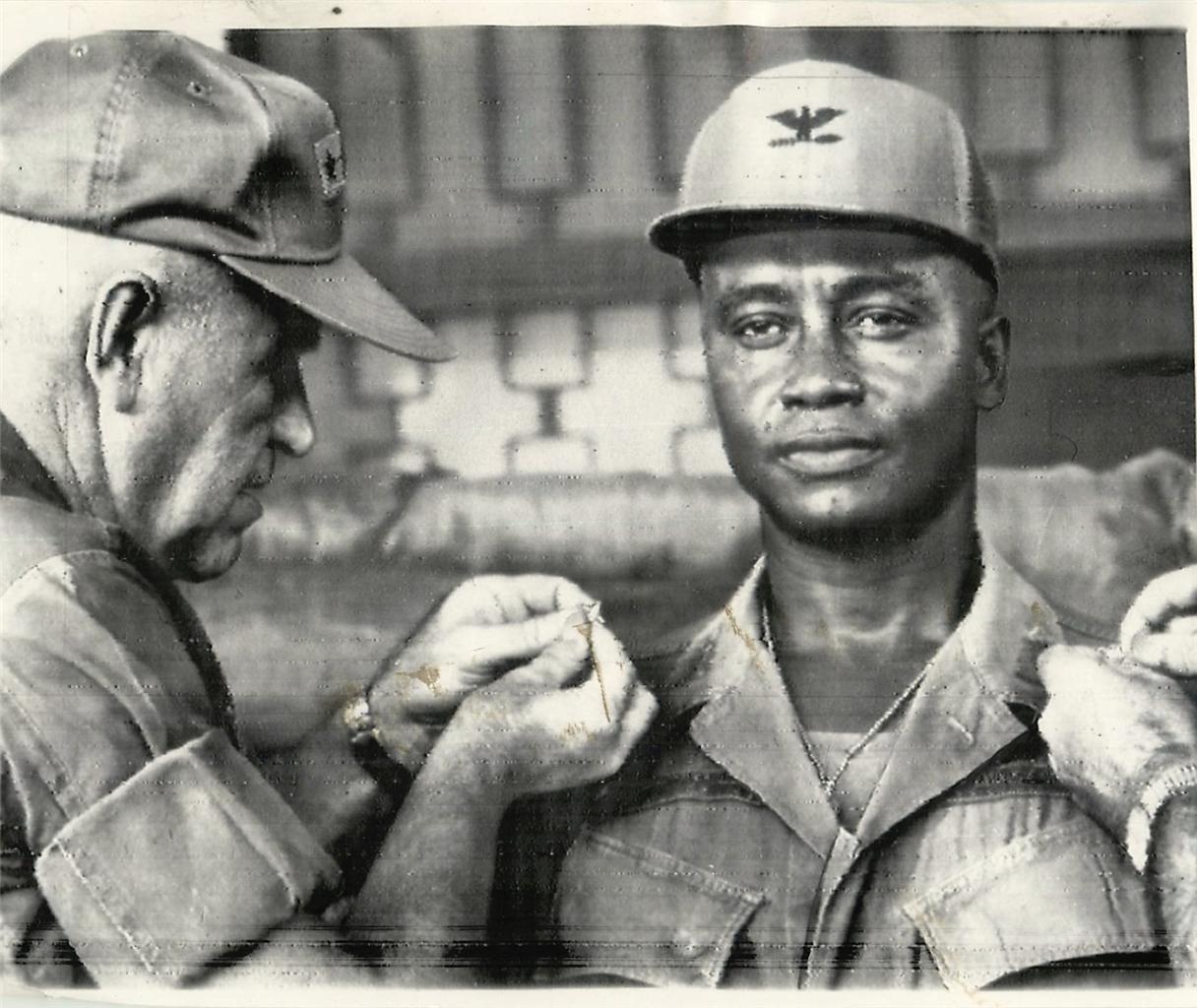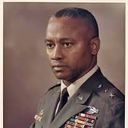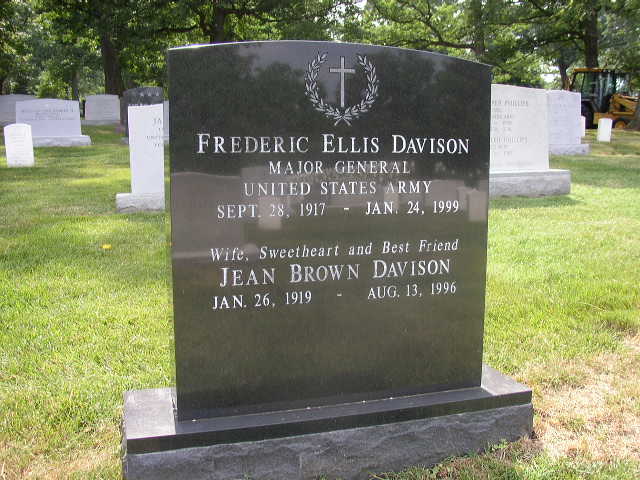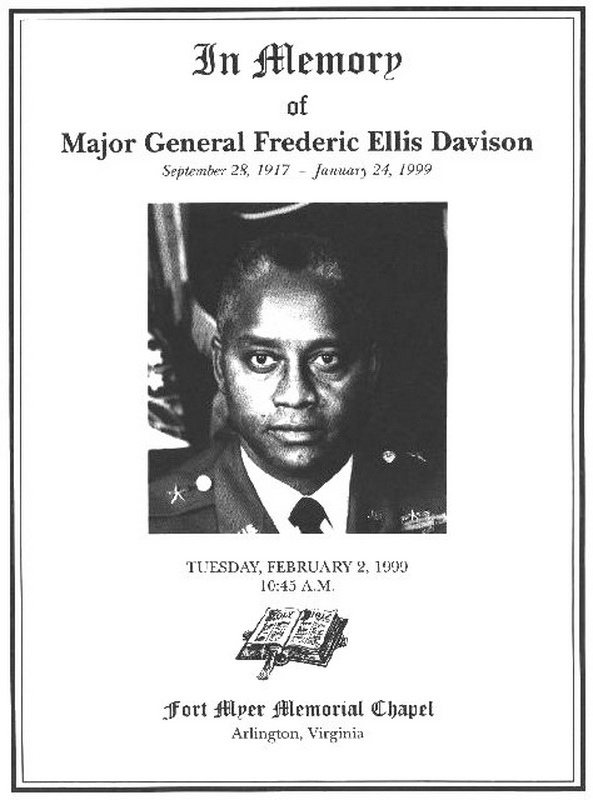You may be gone, no longer living on this earth; but you will live on - in the memories of your family and friends. There will always be a part of you living in those who knew you. You will live on because we remember you!
Davison, Frederic E.
Born: 1917 Died: 1999
Occupation: third African-American general in U.S. history, first African American to command an army division
From: African Americans in the Military, Revised Edition, A to Z of African Americans.
In 1941, Frederic E. Davison joined an army in which blacks and whites served separately and positions of authority went to whites. He rose quickly through the ranks once the barrier of segregation was removed, becoming in 1968 the third African-American general in the U.S. armed forces.
Frederic Ellis Davison was born in Washington, D.C., on September 28, 1917. His father, Albert Charles Davison, died when he was a baby, and Frederic was left in his grandmother's care while his mother, Sue Bright Davison, worked. His grandmother instilled strong values in the boy, counseling him to "Be something worthwhile."
Frederic was a member of the National Honor Society while a student at all-black Dunbar High School. For a time, he viewed medicine as a possible career. He studied zoology and chemistry at Howard University, graduating cum laude in 1938 and earning a master's degree in 1940.
Davison completed ROTC training in college and in 1939 was commissioned a lieutenant in the Army Reserve.
On April 6, 1941, he married Jean E. Brown, a teacher, and just months before the United States entered World War II, he was called to active duty.
During the war, Captain Frederic Davison led an African-American unit, Company B of the 371st Infantry, 92nd Division, which fought from Sicily into mainland Italy. The white officers assigned to the 92nd were of low caliber, the men were poorly trained, and equipment issued to the division was old. To Davison, segregation in the military was a double-edged sword, a hated impediment as well as a challenge. "We didn't feel we were given the true opportunity to show our capabilities," he said. "On the other hand, we tried to prove that even under these handicaps the job could be done." The soldiers of the division took 3,000 casualties and received 12,000 decorations. For his service in World War II, Davison earned the Distinguished Service Medal, the Legion of Merit, the Bronze Star, and the Army Commendation Medal.
Davison enrolled in Howard University Medical School after the war but left after a year to accept a commission in the regular army. In 1947, he was assigned to train an ROTC unit at South Carolina Agricultural and Mechanical College (now South Carolina State University) in Orangeburg. In the early 1950s, he was a battalion operations officer in Germany, serving in the newly integrated armed forces.
Through the 1950s and 1960s, as he and his wife raised four daughters, Davison moved steadily up the army career ladder.
In 1954, he attended the Command and General Staff College at Fort Leavenworth, Kansas. In 1957 he was promoted to lieutenant colonel, and in 1959 he went to Korea as chief of personnel services with the Eighth Army. In 1962, Davison was the first African American to enter the Army War College at Carlisle Barracks, Pennsylvania. A year later he graduated from George Washington University with a master's degree in international affairs and was placed in charge of manpower and reserve matters at the Pentagon. Beginning in 1965, he commanded the 3rd Training Brigade at Fort Bliss, Texas.
In 1967, Davison requested duty in Vietnam and was made deputy commander of the 199th Light Infantry brigade, which was stationed in the defense perimeter of Saigon. The brigade commander was absent in February 1968, when the North Vietnamese launched the series of attacks known as the Tet Offensive, and it was left to Davison to direct the defense of the base at Long Binh. The courage and dedication that Davison displayed earned him profound respect from the soldiers under his command. In August 1968, he became brigade commander.
As commander, Davison was often in the field with the soldiers. "[I]f you want to get to the grass roots and know exactly what the problems and the attitudes of the men are, you've got to talk to them," he explained. On Sundays, he visited the wounded in hospitals, to "let them know I appreciate what they've done, that they've not been forgotten." Davison's decorations earned in Vietnam include the Gallantry Cross with Palm and the Distinguished Service Order, First Class.
In September 1968, in a promotion ceremony at Binh Chanh, General Creighton W. Abrams, U.S. commander in Vietnam, pinned a general's stars on Davison's uniform, making him the third African-American general in U.S. history. Davison followed army general Benjamin O. Davis, Sr., who was retired, and his son, air force general Benjamin O. Davis, Jr., who would retire in 1970.
While Davison and thousands of other African-American soldiers fought a continuing battle for equality within the armed forces, some young African Americans in the United States were joining militant groups such as the Black Panthers and advocating racial separation. Davison was an outspoken critic of this trend, saying, "I envision one America, an integrated America." To the general, contributing to society entitled any citizen to enjoy the full rights of that society.
For nine months—from September 1971 to May 1972—Davison was deputy chief of staff for U.S. Army personnel in Europe. In April 1971, he was promoted to major general. In May 1972, he assumed command of the 8th Infantry Division in Germany, becoming the first African American to lead an army division. He quickly proved himself to be a tough leader who tolerated nothing less than excellence: He relieved from duty three post commanders who failed to enforce regulations designed to further racial tolerance, and he took decisive measures against drug use and drunk driving by soldiers.
On November 12, 1973, Davison was made commander of the Military District of Washington, D.C. He oversaw a force of 3,600 that performed ceremonial functions and remained ready to carry out security and rescue operations at the White House and to aid civil authorities in case of domestic disorder. At the time he was the highest ranking of 12 African-American generals in the army.
General Davison retired from active duty in 1974 and became an executive assistant to the president of Howard University. Before retiring from Howard in 1985, he helped to streamline the university's computer system. In retirement, Davis volunteered on behalf of the homeless, and a homeless shelter in the District of Columbia was named in his honor.
Jean Brown Davison died in 1996; General Frederic E. Davison died on January 24, 1999, following surgery for a kidney ailment.
He was buried at Arlington National Cemetery.
Survivors include four daughters, Jean D. Eubanks of Fairfax, Andrea D. Roberts of Chicago, Dayle A. Davison of New York City and Carla M. Davison of Washington; four grandsons; and a great-grandson.
****************************
Sources: Arlington National Cemetery Website
http://www.arlingtoncemetery.net/fdavison.htm
US Army Major General
Commanding General, 199th Light Infantry Brigade, Vietnam, 1968-1969
Commanding General, 8th Infantry Division, Germany, 1972-1973
Commanding General, Military District of Washington, 1973-1974
First black officer to command a army brigade in combat.
First black officer to reach the rank of Major General and first to Command a army division.
After retirement, he became Executive Assistant to the President of Howard University, his alma mater, retiring from that position after 10 years, in 1985.
Awards and Decorations:
Combat Infantry Badge (Two awards)
Distinguished Service Medal w/1 Oak Leaf Cluster
Distinguished Flying Cross
Legion of Merit
Bronze Star
Air Medal w 3 Silver Leaf Clusters and 3 Oak Leaf Clusters (19 total awards)
Army Commendation Medal
The epitaph on his headstone shows the Commanding General notations noted above and the phrase "These are my credentials".
The words are borrowed from the famous comment made during World War II by Brigadier General Charles Conham when his 8th Infantry Division won the surrender of a German force. A higher-ranking German officer haughtily asked what credentials Conham had to accept the Germans' surrender. Conham gestured to some of the 8th Infantry soldiers who had fought their way through Europe and said simply, "These are my credentials."
**********************************************
.
You may be gone, no longer living on this earth; but you will live on - in the memories of your family and friends. There will always be a part of you living in those who knew you. You will live on because we remember you!
Davison, Frederic E.
Born: 1917 Died: 1999
Occupation: third African-American general in U.S. history, first African American to command an army division
From: African Americans in the Military, Revised Edition, A to Z of African Americans.
In 1941, Frederic E. Davison joined an army in which blacks and whites served separately and positions of authority went to whites. He rose quickly through the ranks once the barrier of segregation was removed, becoming in 1968 the third African-American general in the U.S. armed forces.
Frederic Ellis Davison was born in Washington, D.C., on September 28, 1917. His father, Albert Charles Davison, died when he was a baby, and Frederic was left in his grandmother's care while his mother, Sue Bright Davison, worked. His grandmother instilled strong values in the boy, counseling him to "Be something worthwhile."
Frederic was a member of the National Honor Society while a student at all-black Dunbar High School. For a time, he viewed medicine as a possible career. He studied zoology and chemistry at Howard University, graduating cum laude in 1938 and earning a master's degree in 1940.
Davison completed ROTC training in college and in 1939 was commissioned a lieutenant in the Army Reserve.
On April 6, 1941, he married Jean E. Brown, a teacher, and just months before the United States entered World War II, he was called to active duty.
During the war, Captain Frederic Davison led an African-American unit, Company B of the 371st Infantry, 92nd Division, which fought from Sicily into mainland Italy. The white officers assigned to the 92nd were of low caliber, the men were poorly trained, and equipment issued to the division was old. To Davison, segregation in the military was a double-edged sword, a hated impediment as well as a challenge. "We didn't feel we were given the true opportunity to show our capabilities," he said. "On the other hand, we tried to prove that even under these handicaps the job could be done." The soldiers of the division took 3,000 casualties and received 12,000 decorations. For his service in World War II, Davison earned the Distinguished Service Medal, the Legion of Merit, the Bronze Star, and the Army Commendation Medal.
Davison enrolled in Howard University Medical School after the war but left after a year to accept a commission in the regular army. In 1947, he was assigned to train an ROTC unit at South Carolina Agricultural and Mechanical College (now South Carolina State University) in Orangeburg. In the early 1950s, he was a battalion operations officer in Germany, serving in the newly integrated armed forces.
Through the 1950s and 1960s, as he and his wife raised four daughters, Davison moved steadily up the army career ladder.
In 1954, he attended the Command and General Staff College at Fort Leavenworth, Kansas. In 1957 he was promoted to lieutenant colonel, and in 1959 he went to Korea as chief of personnel services with the Eighth Army. In 1962, Davison was the first African American to enter the Army War College at Carlisle Barracks, Pennsylvania. A year later he graduated from George Washington University with a master's degree in international affairs and was placed in charge of manpower and reserve matters at the Pentagon. Beginning in 1965, he commanded the 3rd Training Brigade at Fort Bliss, Texas.
In 1967, Davison requested duty in Vietnam and was made deputy commander of the 199th Light Infantry brigade, which was stationed in the defense perimeter of Saigon. The brigade commander was absent in February 1968, when the North Vietnamese launched the series of attacks known as the Tet Offensive, and it was left to Davison to direct the defense of the base at Long Binh. The courage and dedication that Davison displayed earned him profound respect from the soldiers under his command. In August 1968, he became brigade commander.
As commander, Davison was often in the field with the soldiers. "[I]f you want to get to the grass roots and know exactly what the problems and the attitudes of the men are, you've got to talk to them," he explained. On Sundays, he visited the wounded in hospitals, to "let them know I appreciate what they've done, that they've not been forgotten." Davison's decorations earned in Vietnam include the Gallantry Cross with Palm and the Distinguished Service Order, First Class.
In September 1968, in a promotion ceremony at Binh Chanh, General Creighton W. Abrams, U.S. commander in Vietnam, pinned a general's stars on Davison's uniform, making him the third African-American general in U.S. history. Davison followed army general Benjamin O. Davis, Sr., who was retired, and his son, air force general Benjamin O. Davis, Jr., who would retire in 1970.
While Davison and thousands of other African-American soldiers fought a continuing battle for equality within the armed forces, some young African Americans in the United States were joining militant groups such as the Black Panthers and advocating racial separation. Davison was an outspoken critic of this trend, saying, "I envision one America, an integrated America." To the general, contributing to society entitled any citizen to enjoy the full rights of that society.
For nine months—from September 1971 to May 1972—Davison was deputy chief of staff for U.S. Army personnel in Europe. In April 1971, he was promoted to major general. In May 1972, he assumed command of the 8th Infantry Division in Germany, becoming the first African American to lead an army division. He quickly proved himself to be a tough leader who tolerated nothing less than excellence: He relieved from duty three post commanders who failed to enforce regulations designed to further racial tolerance, and he took decisive measures against drug use and drunk driving by soldiers.
On November 12, 1973, Davison was made commander of the Military District of Washington, D.C. He oversaw a force of 3,600 that performed ceremonial functions and remained ready to carry out security and rescue operations at the White House and to aid civil authorities in case of domestic disorder. At the time he was the highest ranking of 12 African-American generals in the army.
General Davison retired from active duty in 1974 and became an executive assistant to the president of Howard University. Before retiring from Howard in 1985, he helped to streamline the university's computer system. In retirement, Davis volunteered on behalf of the homeless, and a homeless shelter in the District of Columbia was named in his honor.
Jean Brown Davison died in 1996; General Frederic E. Davison died on January 24, 1999, following surgery for a kidney ailment.
He was buried at Arlington National Cemetery.
Survivors include four daughters, Jean D. Eubanks of Fairfax, Andrea D. Roberts of Chicago, Dayle A. Davison of New York City and Carla M. Davison of Washington; four grandsons; and a great-grandson.
****************************
Sources: Arlington National Cemetery Website
http://www.arlingtoncemetery.net/fdavison.htm
US Army Major General
Commanding General, 199th Light Infantry Brigade, Vietnam, 1968-1969
Commanding General, 8th Infantry Division, Germany, 1972-1973
Commanding General, Military District of Washington, 1973-1974
First black officer to command a army brigade in combat.
First black officer to reach the rank of Major General and first to Command a army division.
After retirement, he became Executive Assistant to the President of Howard University, his alma mater, retiring from that position after 10 years, in 1985.
Awards and Decorations:
Combat Infantry Badge (Two awards)
Distinguished Service Medal w/1 Oak Leaf Cluster
Distinguished Flying Cross
Legion of Merit
Bronze Star
Air Medal w 3 Silver Leaf Clusters and 3 Oak Leaf Clusters (19 total awards)
Army Commendation Medal
The epitaph on his headstone shows the Commanding General notations noted above and the phrase "These are my credentials".
The words are borrowed from the famous comment made during World War II by Brigadier General Charles Conham when his 8th Infantry Division won the surrender of a German force. A higher-ranking German officer haughtily asked what credentials Conham had to accept the Germans' surrender. Conham gestured to some of the 8th Infantry soldiers who had fought their way through Europe and said simply, "These are my credentials."
**********************************************
.
Family Members
Sponsored by Ancestry
Advertisement
Explore more
Sponsored by Ancestry
Advertisement
